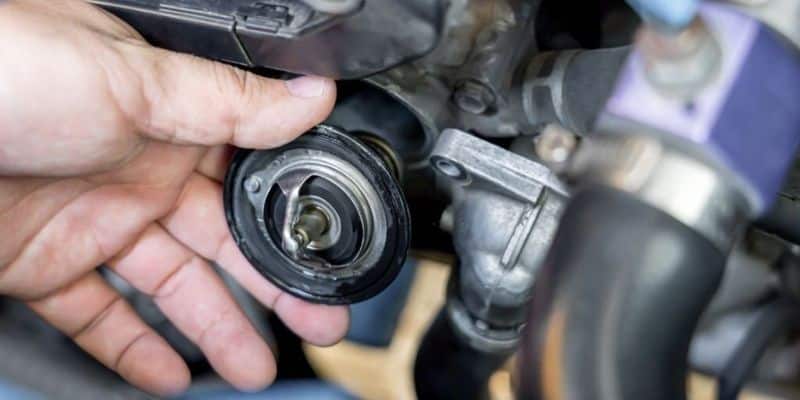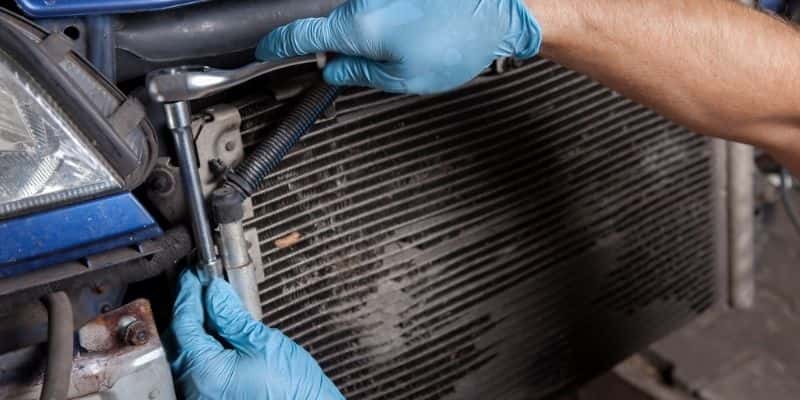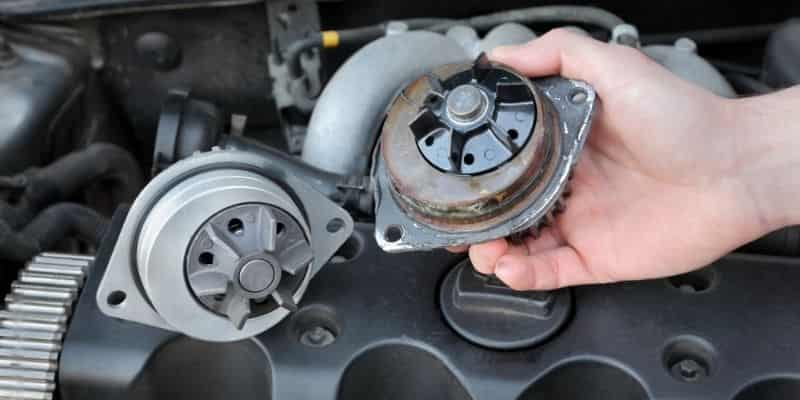Many drivers face this confusing situation when the car engine overheats but the coolant is full. First of all, it seems quite illogical why my car is overheating but it has coolant in it as the coolant is responsible for dissipating the excessive engine heat.
Actually, many engine parts play a role in maintaining the engine temperature, and malfunctioning in any of these parts can cause your engine to overheat.
The malfunctioning thermostat is possibly the main cause of your engine to overheat. The other reasons can be low engine oil, a clogged radiator, or a faulty water pump.
In this article, we will explore the possible causes of engine overheating but coolant full. Furthermore, you will learn the symptoms, causes, and solutions of thermostat problems and other causes. In addition, you will explore the temporary fixes for overheating cars.
Why is my car overheating but it has coolant in it?
Engine overheating is a common cause of engine damage if not addressed. Understanding the problem is crucial before delving into potential solutions.
Engines operate optimally within a specific temperature range. This range ensures efficient combustion and overall performance. When the engine gets too hot, it can lead to various problems, including reduced fuel efficiency, increased emissions, and potential engine damage.
Coolant has a vital role in the engine’s coolant system. It serves as a heat transfer fluid that absorbs excess heat generated during combustion. But many times the car overheats even when the coolant level is okay.
But other radiator issues, faulty thermostats, and water pumps also have significant roles in engine coolant circulation. If any of these parts gets faulty you will notice the engine is overheating but the coolant level will be full.
Actually, this can possibly be due to the malfunctioning of one or more than one part of the engine. Understanding these potential causes is the first step toward diagnosing and resolving the problem to ensure your vehicle runs smoothly and safely.
Causes of Engine Overheating But Coolant Full
Thermostat Malfunction
The thermostat is a small valve that controls the flow of coolant between the engine and the radiator. When the engine is cold, the thermostat valve is closed to restrict coolant flow. This allows the engine to warm up faster.
Once the engine reaches operating temperature, the thermostat opens to allow coolant to flow to the radiator. The radiator cools the coolant before it circulates back to the engine.
If the thermostat valve sticks closed, it will not allow coolant to flow to the radiator even when the engine gets hot. This prevents the coolant from shedding heat. The coolant gets progressively hotter as it circulates within the closed-loop engine system. Eventually, this leads to engine overheating.

The engine overheats because the hot coolant is not getting cooled by the radiator. However, the radiator cap may still be closed with the coolant level full. A stuck closed thermostat prevents coolant exchange even with a full system.
Replacing the faulty thermostat with a new one will fix this issue. The new thermostat will open and close as designed to regulate the flow of coolant. This maintains proper engine operating temperature. Periodic check and replacement of the thermostat ensure it does not fail and cause overheating problems. A well-functioning thermostat is critical for engine temperature control.
Cooling System Leaks
A steady coolant leak over time can create problems with engine overheating. Coolant is crucial to keep an engine from getting too hot during operation. It works to absorb heat from the engine and transfer it to the radiator where air flows through to cool it down.
When coolant leaks out, there is less coolant in the system to perform the heat exchange process. Less coolant means less heat absorption from the engine. With each mile driven, more hot engine parts are exposed without proper cooling. This extra heat builds up in the engine without enough coolant flow.
A small leak may not cause overheating right away. But as the coolant level drops increasingly lower over months, there comes a point where the engine finally exceeds its safe operating temperature threshold.
Once overheated, engine damage such as a warped or cracked head or block can result. Other parts like gaskets may also fail more quickly from ongoing high heat stress.
Having coolant leaks addressed quickly helps prevent such issues. Regular inspections let mechanics spot small leaks before they worsen.
Radiator Issues
The automobile radiator is a vital heat exchanger component that assists in regulating engine temperature.
The main purpose of the radiator is to absorb escalated heat from the engine’s coolant liquid throughout the operation. As the coolant circulates, the radiator’s numerous interlinked tubes allow heat to transfer from the fluid to the surrounding air.
Some prevailing radiator problems are cracked or broken solder joints between tubes, deteriorated seals permitting coolant seepage, and mineral buildup obstructing thermal conduction.
Old age and corrosion also compromise integrity over time. Fouled condensers accrue debris restricting airflow diagnosis, necessitating cleansing or replacement.
Resolving such radiator faults forestalls unwelcome overheating while vehicles operate under high-demand applications. Performing leak tests and pressure checks to catch small issues before escalation.

Removing mineral deposits and thoroughly flushing whole cooling circuits restore fluid-side heat transfer. Reattaching or swapping damaged radiator components reinstates designed thermal efficiency for engine dependability. Such proactive radiator restoration preserves ideal temperature regulation and forestalls costly repairs down the street.
Water Pump Failure
The water pump serves a vital circulatory role in the cooling and lubrication system of any motor vehicle. This essential component works to propel coolant liquid around the engine block and radiator core to dissipate damaging heat buildup.
As the pump Bearings and impeller wind down over time, warning indicators may arise. A reduced coolant flow rate allows heat to accumulate more quickly, triggering the temperature gauge higher than usual. Air bubbles entering the system from leaks compromise fluid molecular cohesion properties.
To properly diagnose potential issues, first inspect for external water pump leaks or damage. With an engine at operating temperature, feel radiator and heater hose pulsations verifying Heater core clogging.
Next, check coolant temperature dynamics during varied loading situations like idling versus maximum output torque production.
Air in the Cooling System
When air enters the cooling system of a vehicle, it prevents the efficient circulation of coolant. Air pockets occur as coolant is drawn out of the radiator and heater core as the engine warms up. These air pockets disrupt the flow of coolant and insulate the engine rather than transferring heat away from it. Over time, excessive air can lead to overheating issues.
To bleed air from the system, start by fully opening the radiator’s petcock or radiator drain plug located at the lowest point of the radiator. This allows any trapped air to escape.
Next, loosen the bleed screw or bolt on the thermostat housing or on a hose connecting to the housing. Have someone start the engine while you observe the bleed point.
Once coolant starts to slowly drip out with no bubbles, tighten the bleed screw. Top off the coolant reservoir as needed.
Repeating this process at other high points in the system ensures maximum cooling efficiency. Proper bleeding minimizes disruptions to protect the engine.
Cooling Fan issue
A radiator fan is crucial for efficient cooling of the engine. As hot coolant passes through the radiator, the fan works to pull air through the radiator cores so the heat can dissipate. A failed or faulty radiator fan prevents proper air circulation through the radiator even when coolant levels are full.
Without enough air being forced through the radiator, the coolant cannot effectively release its heat into the air. The warm coolant continues circulating back to the engine. Over time, the engine temperature begins to rise above safe levels and can lead to overheating.
Some signs of an overheating engine from a bad radiator fan include steam under the hood, a temperature gauge in the red zone, burning smells, and engine components that may become damaged.
Replacing a non-functioning radiator cooling fan ensures adequate airflow through the radiator at all times. This keeps the coolant temperatures low to protect today’s high-powered engines from overheating, even with full coolant levels.
Fixes for Overheating Car Engine
Thermostat Replacement
Here is a step-by-step guide to replacing a malfunctioning thermostat:
- Start by draining the engine coolant from the coolant system.
- Locate the thermostat housing, usually near the engine cylinder head.
- Remove any securing bolts or clips holding the housing in place.
- Pull off the housing and remove the faulty thermostat.
- Inspect the housing gasket and replace it if worn.
- Install the new thermostat into the housing, making sure it is oriented correctly.
- Replace the housing gasket with a new one.
- Slide the housing back into position and secure it with bolts or clips.
- Refill the cooling system with fresh coolant following the manufacturer’s specifications.
- Bleed any air from the system by loosening bleed bolts.
- Replace any removed parts to ensure proper seals. Start the engine and monitor for leaks.
Proper thermostat replacement ensures coolant circulates at optimal temperature for safe engine operation and fuel efficiency.
Repairing Cooling System Leaks
Several methods are used to repair or replace damaged components in the cooling system. Minor cracks in plastic parts like water pumps or radiators can be sealed with epoxy. Larger cracks require replacing the part to avoid leaks.
Corroded or weakened metal components like hoses, pipes, or the water neck must be replaced rather than repaired. Replacing is the best option if the damage is severe.
For components that cannot be economically repaired like the cylinder head, a replacement part is necessary to avoid overheating risk. Proper tools are needed for part removal and installation. O-ring lubricant is applied for seals.
Gaskets are replaced rather than reused. Refilling with antifreeze follows repair. Periodic system flushing can prevent corrosion damage and extend part service life. Regular maintenance prevents costly repairs by spotting issues early.
Radiator Maintenance and Repair
Here is a maintenance guide on maintaining and troubleshooting the radiator, along with repair options:
- Proper radiator maintenance ensures efficient heat dissipation.
- Visually inspect for leaks and debris buildup, which can clog radiator cores.
- Flush the radiator annually using a garden hose from the inlet and outlet sides. This removes mineral deposits and rust.
- Check radiator, condenser, and cooling fan operation.
- Replace worn or slipping fan belts. Thermal images detect coolant flow issues. Overheating could indicate a faulty water pump, a stuck thermostat, or air in the system.
- Test cooling fan relay and wiring. Radiators damaged by corrosion may be re-cored or repaired. A cracked tank typically requires replacement. Heavy pitting allows for welding.
- Ensure clamps and fans securely mount a replacement radiator.
Prompt repairs prevent further damage and relieve overheating pressures on engine components.
Water Pump Replacement
Water pump replacement is crucial for the overheating engine if the water pump blockage is the reason for overheating. Here is step by step guide to replace the water pump:
- Drain the coolant from the system.
- Remove any accessories mounted on the timing cover, such as air conditioning lines.
- Loosen the drive belt from the pump pulley.
- Tag any removed belts to ensure correct reinstallation. Loosen the bolts or mounts securing the water pump.
- Lift out the old pump, taking note of the shaft seal and gasket positions.
- Clean and inspect the mounting surface.
- Install a new seal and gasket, carefully fitting them onto the pump shaft.
- Mount the replacement pump, applying thread sealant to bolt threads. Hand tighten bolts, then torque in a criss-cross pattern.
- Refit the drive belt and related accessories.
- Fill the system with fresh coolant and purge air from bleed valves.
- Start the engine and inspect for leaks.
A functioning water pump uniformly circulates coolant, preventing localized hot spots that damage engines over the long term.

Bleeding the Cooling System
Here is a step-by-step guide for removing air from the cooling system:
- Start by loosening the radiator or expansion tank cap to allow trapped air to escape.
- Ensure the Coolant recovery tank is positioned higher than the radiator.
- Loosen any air bleed bolts located on high spots in the system, usually on the engine. This includes the thermostat housing.
- With someone starting the engine, bleed air out by loosening bolts until a steady flow of coolant without bubbles emerges. Have them cycle the engine on and off to help release air pockets.
- Once bled, retighten the bolts securely.
- Top off the coolant as needed when finished. Bleed other high points one by one using this process.
- Finally, fill the radiator until coolant reaches the base of the filler neck.
- Replace the radiator cap tightly.
Proper bleeding ensures heat transfer without disruptions caused by air in the lines.
Read More: Temporary Fixes for Overheating Car Engine
Symptoms of an Overheating Car
An overheating car engine demands immediate attention, as it can lead to severe damage and costly repairs. Recognizing the symptoms of engine overheating is essential for both the safety of your vehicle and your wallet. Here are some common symptoms of car overheating.
1. Elevated Temperature Gauge:
The most apparent sign of engine overheating is an elevated temperature gauge on your vehicle’s dashboard. In many cars, the gauge moves into the red zone or displays a “H” for “Hot” when the engine temperature exceeds the normal operating range.
2. Steam or Smoke from the Engine:
When the engine overheats, it generates excessive heat that can cause steam or smoke to emanate from under the hood. This is a clear indication that the engine is running too hot.
3. Warning Lights:
Modern vehicles are equipped with warning lights, such as the “Check Engine” or “Temperature” light. When the engine temperature surpasses safe levels, these lights illuminate the dashboard to alert the driver.
4. Reduced Engine Power:
An overheating engine may go into a “limp mode” to protect itself from further damage. This mode restricts engine power, resulting in reduced performance and acceleration.
5. Unusual Engine Noises:
Overheating can cause unusual noises like pinging or knocking as components expand and contract due to extreme temperature changes. These noises are an alarming sign of engine distress.
6. Coolant Leakage:
If you notice coolant pooling under your vehicle, it’s a sign of a potential coolant leak. An engine that’s losing coolant will struggle to maintain proper temperature.
7. Burning Smell:
An overheating engine can produce a burning smell, often emanating from the engine compartment. This smell is indicative of overheated components or leaking fluids.
8. Throttle Response Issues:
Overheating can affect the electronic throttle control system, causing erratic throttle response and making the vehicle difficult to control.
9. Increased Exhaust Emissions:
A seriously overheating engine may produce excessive exhaust emissions, often characterized by white or blue smoke from the tailpipe.
10. Loss of Power Steering or Brake Assistance:
In some cases, engine overheating can make the car stall, and impact power steering or brake assistance, making it challenging to steer or stop the vehicle effectively.
When you encounter these signs, it’s crucial to pull over safely, turn off the engine, and seek professional assistance to diagnose and rectify the underlying issue. Ignoring the symptoms of engine overheating can lead to severe and costly engine damage.
Faqs on Engine Overheating
Why is my engine overheating despite having enough coolant?
A common cause of overheating engines is radiator or coolant passages that have become clogged over time with mineral deposits or debris, reducing the ability of a liquid to transfer heat through the radiator cores.
Other likely factors include a worn-out water pump that is no longer properly circulating coolant, or a stuck open or closed thermostat that prevents the coolant from reaching its optimal operating temperature.
What happens if I continue to drive with an overheating engine?
If you continue driving with an overheating engine, it could cause serious damage:
- The head gasket may fail, allowing coolant to mix with the engine oil. This can ruin both the engine and transmission.
- Continued high temperatures can crack the engine block or cylinder head. This level of damage means the engine would need to be replaced.
- Pistons may seize or warp from the extreme heat, breaking connecting rods and crankshafts.
- Valves and valve seats could be burnt, bent, or pitted, necessitating an expensive head rebuild.
- Bearings may seize up and destroy themselves once they heat beyond their safe operating range.
- Hoses and pipes carrying coolant can degrade rapidly and develop leaks under overheating conditions.
- Vital components like water pumps and timing belts are more likely to suddenly fail when stressed by high heat.
Can I use water instead of coolant in an emergency?
Yes, you can use water instead of coolant in a state of emergency. But make to replace it with proper coolant as soon.
How often should I flush my radiator?
It is recommended to flush the car radiator every 2 years or 24,000 miles. This helps remove mineral buildup.
What are the long-term consequences of engine overheating?
Here are some potential long-term consequences if an engine continues to overheat without proper repair:
- Head gasket failure: Repeated heating and cooling can cause the head gasket to fail over time, leading to combustion gas and coolant leaks between engine compartments.
- Cracked engine block: Prolonged high heat exposure can cause small cracks to form in the block material until it fully fractures. A cracked block means the engine needs replacement.
- Warped cylinder head: Heat warping of the cylinder head can occur gradually, causing compression and combustion issues that affect power and performance.
- Excessive engine wear: Bearings, pistons, valves, and other parts will wear much faster under overheating conditions, reducing component life spans.
Conclusion
An overheating engine issue despite sufficient coolant presents a problem that requires diagnosis and resolution. As discussed, there can be several underlying mechanical causes impeding the efficient flow and heat transfer capability of the cooling system.
From debris-clogged passages to failed water pumps, an overheating engine is a symptom of circulation or heat dissipation defects. Without fixes, continued driving in such conditions will only exacerbate damage over the long term. Owners should never ignore high-temperature warnings and instead get a qualified technician to properly inspect, test, and repair any root problems immediately.

Joseph Morgan has decades of automotive experience. The Detroit native started restoring classics in the 1970s. He owned a vintage repair shop and authored articles for car magazines. With a 1965 Mustang fastback of his own, Joseph now shares advice through his YouTube channel. From engine swaps to rust repair, his expertise helps preserve automotive history.
